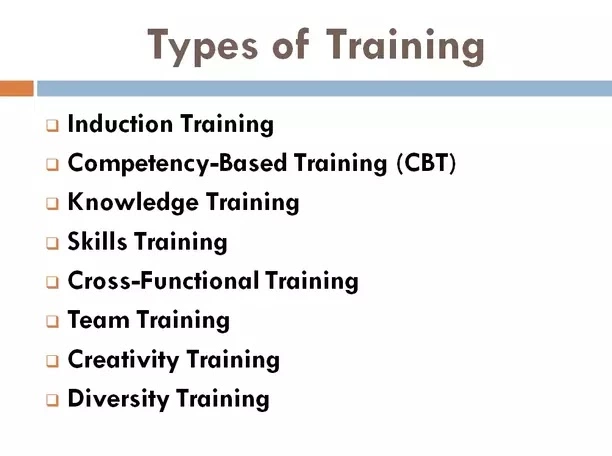Table of Contents:
- Types of Training
- Importance of Training
Types of Training
Many types of training and development programmes are followed by companies.
Some of them are as follows:
1) Induction Training
Induction training, also known as orientation training is conducted to introduce the new employees to the organization and its culture. This training plays a very important role in making them comfortable and settling them quickly within the environment of the organisation. Under this training method, new staff is introduced to the goals and objectives of the company, rules and regulations to be followed, activities to be performed by them, expectations from them, policies to be undertaken, etc.
2) Competency-Based Training (CBT)
Competency-Based Training is a kind of vocational training in which new employees are trained according to the standards of the organisation. It does not focus on individual development but determines the capabilities of the individual at the workplace after giving proper training. It trains the new employees for the competition that they may face in future.
3) Knowledge Training
Employees working in any company must have thorough knowledge about the job they are going to perform. Thus, knowledge training is given to new employees to enhance their knowledge and understanding regarding any particular issue of the organisation. This type of training not only motivates the employees to perform better but also helps the concern in maintaining a more efficient and attentive staff that further prepares the organisation against various competitions.
4) Skills Training
Certain basic skills are required by an individual in his entire working period in the company. These skills such as self-management, leadership, coordination, computations, communication, etc., are imparted through lectures, counselling, workshops, apprenticeship and various other methods within the company itself. This kind of training programme is very common in organisations.
5) Cross-Functional Training
It is usually given to employees who can undertake job responsibilities of other departments easily. There are a few methods by which this type of training can be given to the employees like job rotation, in which the employees are asked to perform different jobs of the same functional area, in different sections of the organisation for a certain time duration, so that they can understand the working of other departments also. Besides this, good performers can also guide other employees on how to deal with other departmental operations and functions.
6) Team Training
Content tasks and group processes are the two fields that come in this type of training. Content tasks are aimed at specifying the objectives of the team such as profit-making, cost management, problem-solving etc. While group processes aim to reveal how the group members work as a team, the way they interact, resolve conflicts, etc. Organisations adopt various training methods like adventure learning to develop esprit de corps among the group members.
7) Creativity Training
In today’s competitive world, every organisation needs innovative and experienced candidates for their company. One who thinks out of the box is considered a most creative person and this is what organisations are searching for. Thus, the corporate sectors use various brainstorming methods and creativity training techniques to provide such training to new employees, which makes them pioneers. more competent with outstanding performance.
8) Diversity Training
Diversity training focuses on increasing awareness about cultural diversity among employees and how pleasant working conditions can be developed in a cross-cultural working environment. This type of training helps employees to cope with the cross-cultural sensitivity issue.

Importance of Training
The importance of training can be underlined as follows:
1) Decrease in Production Expenditure
Training helps employees to do their work to the best of their capabilities in the most economical way. It results in the greatest use of resources available within the organisation. This helps the organisation to cut their cost in re-work and non-economical methods.
2) Reduces Chances of Accident
A trained person uses the machine very efficiently; as he has been taught to use it to its full capacity, which reduces the chances of accidents or mishaps.
3) Steadiness in the Organisation
Training helps employees to work efficiently. This helps the organisation to free a person, who is supervising them. It also boosts confidence in the employees, who work without absenteeism and with dedication.
4) Increases Employee Confidence
The trained workers can do their jobs in inappropriate ways and can understand the procedures and methods without any difficulty. Hence, employees gain trust, and confidence and start working to their full potential to attain job satisfaction.
5) Improved Levels of Quantity and Quality
Training leads to better production of goods in large quantities, which is qualitatively superior as well.
6) Identification of Efficient and Non-Efficient Employees
Training helps to differentiate between an efficient and a non-efficient person. With the help of training, it is easy to find the person who can learn and perform the tasks quickly and those who are slow learners and performers.
7) Minimum Need of Supervision
If a trained person is operating machinery, there will be no need for a supervisor; as an employee, he is sufficient enough to do a good job.
8) Useful for Managers
As managers are free from the workload of supervision, it becomes easier for them to focus on other vital issues of an organisation.
9) Improves Understanding of Power
Training gives the person a better understanding of the procedure, in which he is involved. One can understand the technical details of the process on his own, which helps in providing better results.
You May Also Like:-
